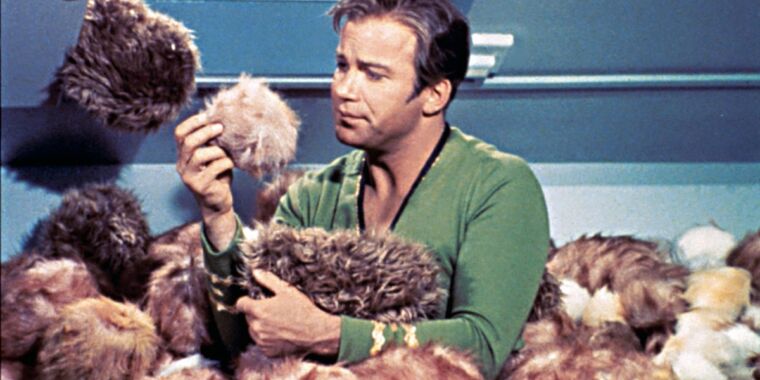Physics undergrads crunched numbers for Star Trek’s tribble problem - 3 minutes read
 Chalk this one up to fun scientific papers we inexplicably missed last year. A group of undergraduates at the University of Leicester in the UK calculated the growth rate of the fictional Star Trek critters known as tribbles. They published their results in a short paper in the university's undergraduate-centric Journal of Physics Special Topics, estimating just how long it would take for there to be enough tribbles to fill up the USS Enterprise.
Chalk this one up to fun scientific papers we inexplicably missed last year. A group of undergraduates at the University of Leicester in the UK calculated the growth rate of the fictional Star Trek critters known as tribbles. They published their results in a short paper in the university's undergraduate-centric Journal of Physics Special Topics, estimating just how long it would take for there to be enough tribbles to fill up the USS Enterprise.First aired on December 29, 1967, "The Trouble with Tribbles" episode was written by David Gerrold, then a 23-year-old college student in California. He originally envisioned it as a cautionary tale of ecological disaster—inspired in part by how quickly rabbits multiplied when they were first introduced to Australia in 1859, a region where they had no natural predators. However, over several rewrites, the tone evolved to incorporate more humor—much to the dismay of ST:TOS creator Gene Roddenberry, who thought the episode lacked gravitas. Roddenberry was ultimately proven wrong. The episode frequently ranks among the top ten best episodes of ST:TOS, if not the entire franchise.
In the episode, the Enterprise is charged with guarding a shipment of "quadrotriticale" grain to Sherman's Planet. While on shore leave, Lt. Uhura (Nichelle Nichols) is given a purring ball of fluff called a Tribble by interstellar trader Cyrano Jones (Stanley Adams) and brings it aboard the ship. The tribble quickly reproduces, and its offspring reproduce in turn.
While the crew initially finds them adorable, McCoy and Spock express concern that the critters will multiply so rapidly that they will eat all the available food on board. Those fears turn out to be valid when Kirk discovers the tribbles have been gorging themselves on the quadrotriticale grain stores they had been charged with guarding. On the plus side, the tribbles' natural aversion to Klingons helps unmask a Klingon in disguise aboard the Enterprise, Arne Darvin (Charlie Brill).
It's a relatively simple calculation involving an exponential formula, ideal for creative homework problems. In the episode, Spock estimates that each tribble (born pregnant) can give birth to ten offspring in 12 hours and pegs the number of tribbles on board after just three days at 1,777,561. The students assumed Spock's assessment was correct, and their calculation also assumed no tribbles died. They also estimated that it would take 18.4×109 tribbles to entirely fill the USS Enterprise. Under those conditions, they concluded that, given the rate of exponential growth, it would take 4.5 days for tribbles to completely fill the ship.
Of course, in the episode, the tribbles do not grow exponentially unchecked, instead beginning to die out because they have been feeding on contaminated grain, courtesy of the aforementioned undercover Klingon. That might warrant a follow-up paper. "A further calculation including a 'death term' could be done, to find out how long it would take for the population to become extinct, if there was an unlimited supply of toxic grain," the authors wrote.
Source: Ars Technica
Powered by NewsAPI.org